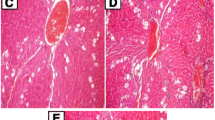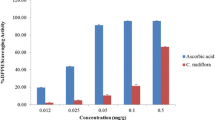Abstract
Carbon tetrachloride (CCl4) is a xenbiotic that can cause cellular damage with free radical production. Calcium fructoborate (CFB) is a boron-based nutritional supplement with antioxidant properties. Calcium fructoborate used in our study is marketed by Future Ceutical Corporation as FruiteX-B, which has a chemical structure similar to the natural form of boron found in edible plants. In this study, it was aimed to determine the antioxidant activity, DNA damage, and histopathological effects of CFB on the liver and kidney tissues of rats in the toxicity induced by CCl4. During 14 days of treatment, 42 wistar albino rats were divided into 7 in each group, control group, olive oil (0.25 ml twice a week), CFB (1 mg/day), CFB-CCl4 (1 mg/day, twice a week 0.5 ml), ZY-CFB (0.25 ml/twice a week, 1 mg/2 times day twice), and CCl4 (0.5 ml twice a week). AST, ALT, HDL, LDH, urea, creatinine, triglyceride, total protein and albumin levels were analyzed in the blood serum of rats. The antioxidant defense system enzymes CAT, GR, GPx, SOD activities and GSH, MDA and 8-OHdG levels in liver and kidney tissues were determined and evaluated. In addition, liver and kidney tissues were examined with only hispatological tests. As a result of the findings, it shows that CCl4 disrupts antioxidant defense mechanisms by disrupting some enzyme systems in the kidney and liver. CFB (Fruit-XB), a boronbased dietary supplement, regulates antioxidant metabolism by strengthening biochemical metabolic profiles against oxidation, and also has a protective effect against DNA damage caused by oxidation. Thus, it was concluded that CFB has antioxidant property against CCl4-induced liver and kidney toxicity.


Similar content being viewed by others
Data Availability
All data used during the study appear in the submitted article and availability.
References
Pope A, Rall D (1995) Committee on curriculum development in environmental medicine, institute of medicine. Integrating a Missing Element into Medical Education. National Academies Press, Washington, Environmental Medicine, p 1139
Thrall KD, Vucelick ME, Gies RA, Zangar RC, Weitz KK, Poet TS, Springer DL, Grant DM, Benson JM (2000) Comparative metabolism of carbontetrachloride in rats, mice, and hamsters using gas uptake and PBPK modeling. J Toxicol Environ Health A 60: 531–548 https://pubmed.ncbi.nlm.nih.gov/10983521/
Basu S (2003) Carbon tetrachloride ınduced lipid peroxidation: eicosanoid formation and their regulation by antioxidant nutrients. Toxicology 189: 113–127 https://pubmed.ncbi.nlm.nih.gov/12821287/
Orfila C, Lepert J C, Alric L, Carrera G, Beraud M, Vinel JP, Andpipy B (1999) Expression of TNF-alpha and ımmuno histochemical distribution of hepatic macrophage surface markers in carbontetrachloride-ınduced chronic liver ınjury ın rats. Histochem J 31: 677–685 https://pubmed.ncbi.nlm.nih.gov/10576417/
Lima CF, Fernandes-Ferreira M, Pereira-Wilson C (2007) Drinking of salvia officina listea increases CCI4-induced hepatotoxicity in mice. Food Chem Toxicol 45(3): 456- 464 https://pubmed.ncbi.nlm.nih.gov/17084954/
Sahreen S, Khan MR, Khan RA (2013) Ameliorating effect of various fractions of rumexha status roots against hepato and testicular toxicity caused by CCl4. Oxidmed Cell Longev 1: 1–11 https://pubmed.ncbi.nlm.nih.gov/23766852/
Bolanos L, Lukaszewski K, Bonilla I, Blevins D (2004) Why boron? Plant Physiol Biochem 42(11):907–912. https://doi.org/10.1016/j.plaphy.2004.11.002
Uluisik I, Karakaya HÇ, Koç A (2018) The importance of boron in biological systems. J Trace Elem Med Biol 45:156–162 https://pubmed.ncbi.nlm.nih.gov/29173473/
Abu Ali H, Dembitsky V, Srebnik M (2005) Contemporary aspects of boron: Chemistry and Biological Applications, Elsevier Science, 22, United State of America. 630
Uçkun Z (2013) Esansiyel bir komponent: bor-borun günlük alımı ve fizyolojik etkileri. J Turkish Sci Rev 6:119–123 http://www.derleme.gen.tr/index.php/derleme/article/view/197
Nielsen FH (1997) Boron in human and animal nutrition. Plant Soil 193:199–208. https://doi.org/10.1023/A:1004276311956
Miljkovic D, Scorei RI, Cimpoiaşu VM, Scorei JD (2009) Calcium fructoborate: plant-based dietary boron for human nutrition. J Diet Suppl 6(3): 211–226 https://pubmed.ncbi.nlm.nih.gov/22435474/
Scorei RI, Rotaru P (2011) Calcium fructoborate-potential anti-inflammatory agent. BiolTrace Elem Res 143: 1223–1238 https://pubmed.ncbi.nlm.nih.gov/21274653/
Wagner CC, Ferraresi Curotto V, Pis Diez R (2008) Experimental and theoretical studies of calcium fructoborate. Biol Trace Elem Res 122:64–72 https://pubmed.ncbi.nlm.nih.gov/18227977/
Hu H, Penn SG, Lebrilla CB, Brown PH (1997) Isolation and characterization of soluble boron complexes in higher plants. Mech Phloemmobility Boron, Plantphysiol 113(2):649–655. https://doi.org/10.1104/pp.113.2.649
Miljkovic D (1998) Boron carbohydrates complexes and uses. There of. October 8, US Patent 5962049 https://patents.justia.com/patent/5962049.
Miljkovic D, Scorei RI, Cimpoiaşu VM, Scorei JD (2009) Calcium fructoborate: plant-based dietary boron for human nutrition. J Diet Suppl 6(3): 211–226. https://pubmed.ncbi.nlm.nih.gov/22435474/
Scorei R, Ciubar R, Iancu C, Mitran V, et al. (2007) In vitro effects of calcium fructoborate on fmlp-stimulated human neutrophil granulocytes. Biol Trace Elem Res 118: 27–37 https://pubmed.ncbi.nlm.nih.gov/17848728/
Scorei RI, Ciofrangeanu C, Ion R, et al. (2010) In vitro effects of calcium fructoborate upon production of inflammatory mediators by lps-stimulated raw 264.7 macrophages. Biol Trace Elem Res 135:334–344 https://pubmed.ncbi.nlm.nih.gov/19669712/
Scorei RI (2011) Calcium fructoborate: plant-based dietary boron as potential medicine for cancer therapy. Front Biosci 3(1): 205–215 https://pubmed.ncbi.nlm.nih.gov/21196370/
Samarghandian S, Azimi-Nezhad M, Samini F, Farkhondeh T (2015) Chrysin treatment ımproves diabetes and its complications in liver, brain, and pancreas in streptozotocin-ınduced diabeticrats. Can J Physiol Pharmacol 94(4): 388–393 https://pubmed.ncbi.nlm.nih.gov/26863330/
Scorei R, Cimpoiasu VM, Iordachescu D (2005) In vitro evaluation of the antioxidant activity of calcium fructoborate. Biol trace elem res 107: 127–134 https://pubmed.ncbi.nlm.nih.gov/16217137/
Lartillot S, Kedziora P, Athias A (1988) Purification and characterization of a new fungal catalase. Prep Biochem 18 (3): 241–246 https://pubmed.ncbi.nlm.nih.gov/3237642/
Beutler E (1963) Improved method for determination of blood glutathione. J Lab Clin Med 61 (5): 882–888 https://pubmed.ncbi.nlm.nih.gov/13967893/
Lawrance RA, Burk RF (1976) Glutatyonperoxidase activity in selenium deficient rat liver. Biochem Biophsicak Res Commun 71(4):952–958
Calberg I, Mannervik B (1975) Purification and characterization of flavoenzyme glutathione reductase from rat liver. J Biol Chem 250:5475–5480
Dubovskiy IM, Martemyanov VV, Vorontsova YL, Rantala MJ, Gryzanov EV, Glupov VV (2008) Effect of bacteria infection on antioxidant activity and lipid peroxidation in the midgut of galleriamellonella l. larvae (Lepidoptera, Pyralidae). Comp Biochem Physiol C Toxicol Pharmacol 148 (1): 1–5
Sun Y, Oberley LW, Li Y (1988) A simple method for clinical assay of superoxide dismutase. Clin Chem 34:497–500
Hunt CD (1996) Biochemical effects of physiological amounts of dietary boron. J Trace Elem Exp Med 9:185–213
Kurtoğlu V, Kurtoğlu F, Akalın PP (2018) The effects of various levels of boron supplementationon live weight, plasma lipid peroxidation, several biochemical and tissue antioxidant parameters of male mice. J Trace Elem Med Biol 49:146–150 https://pubmed.ncbi.nlm.nih.gov/29895365/
Eren M, Uyanık F (2012) Effects of dietary boric acid and borax supplementation on growth performance and some biochemical parameters in broilers. Rev Med Vet 163:546–551
Başoğlu A, Sevinç M, Güzelbektaş H, Civelek T (2000) Effect of borax on serum lipid profile in dogs. Online J of Vet Res 4:153–156
Samman S, Naghii MR, Lyons PM, Wall AP, Verus P (1998) The nutritional and metabolic effects of boron ın humans and animals. Biol Trace Elem Res 66: 227–23 https://pubmed.ncbi.nlm.nih.gov/10050922/
Mahmoud Y, Mahmoud AA (2016) Role of nicotinamide (vitamin b3) in acetaminophen ınduced changes in rat liver: nicotinamide effect in acetaminophen-damaged liver. Exp Toxicol Pathol 68:345–354 https://pubmed.ncbi.nlm.nih.gov/27211843/
Engelman J, Volk J, Leyhauseng Geurtsen W (2005) ROS formation and glutathione levels in human oral fibroblasts exposed to TEGDMA and camphorquinone. J Biomed Mater Res B Appl Biomater 75: 272–276 https://pubmed.ncbi.nlm.nih.gov/16080163/
Cabre M, Camps J, Paternain JL, Ferre N, Joven J (2000) Time-course of changes in hepatic lipid peroxidation and glutathione metabolism in rats with carbon tetrachloride-induced cirrhosis. Clin Exp Pharmacol Physiol 27(9):694 99 https://pubmed.ncbi.nlm.nih.gov/10972535/
İnce S, Keles H, Erdogan M, Hazman O, Küçükur I (2012) Protective effect of boric acid against carbon tetrachloride induced hepatotoxicity in mice. Drug Chem Toxicol 35: 285–292 https://pubmed.ncbi.nlm.nih.gov/21999471/
Kısaçam AM, Kocamüftüoğlu G, Ozan İE, Yaman M, Ozan S (2020) Calcium fructoborate prevents skin cancer development in balb-c mice: Next Part, reverse inflammation, and metabolic alteration. Biol Trace Elem Res. https://doi.org/10.1007/s12011-020-02363-w
Korkmaz M, Türkmen R, Demirel H, Sarıtaş ZK (2019) Effect of boron on the repair of osteochondral defect and oxidative stress in rats: an experimental study. Biol Trace Elem Res 187:425–433 https://pubmed.ncbi.nlm.nih.gov/29869015/
Karaca Ö, Pekmez H, Kuş MA, Akpolat N, Ögetürk M, Kuş İ (2011) Deneysel karbon tetraklorür toksisitesi sonucu karaciğerdeki IŞP70 immunoreaksiyon artışı üzerine melatonin hormonunun etkisi. FÜ Sağ Bil Tıp Dergisi 25 (2): 73–76 http://dspace.balikesir.edu.tr/xmlui/handle/20.500.12462/4715
Eşrefoğlu M, Çetin A, Taşlıdere E, Elbe H, Ateş B, Tok OE, Aydın MS (2017) Therapeutic effects of melatonin and quercetin in improvement ofhepatic steatosis in rats through supression of oxidative damage. Bratis lMed J 118 (6): 347–354 https://pubmed.ncbi.nlm.nih.gov/28664744/
Çoban F, İnce S, Küçükkurt, Demirel H, Hazma O (2015) Boron attenuates malathion-induced oxidative stress and acetylcholinesterase inhibition in rats. Drug Chem Toxicol 38: 391–399 https://pubmed.ncbi.nlm.nih.gov/25342379/
Sahreen S, Khan M, Khan RA, Alkreathy HM (2015) Protective effects of carissa opaca fruits against CCI4-induced oxidative kidney lipid peroxidation and trauma in rat. Food Nutr Res 59: 1–11 https://pubmed.ncbi.nlm.nih.gov/26350293/
Acaroz U, İnce S, Arslan Acaröz D, Gürler Z, Kücükkurt I, Demirel HH, Arsla H. O., Varol N, Zhu K (2018) The ameliorative effects of boron against acrylamide-induced oxidative stress, ınflammatory response, and metabolic changes in rats. Food Chem Toxicol 118: 745–752 https://europepmc.org/article/med/29913234
Salmon AB, Richardson A, Perez VI (2010) Update on the oxidative stress theory of aging: does oxidative stress play a role in agingor healthy aging? Free Radic Biol Med 48: 642–655 https://www.ncbi.nlm.nih.gov/pmc/articles/PMC2819595/
Makni M, Chtourou Y, Garoui EM, Boudawara T, Fetoui H (2012) Carbon tetrachloride-ınduced nephrotoxicity and DNA damage in rats: protective role of vanillin. Hum Exp Toxicol 31: 844–852 https://pubmed.ncbi.nlm.nih.gov/22751287/
Wunjuntu K, Kettawan A, Charoenkiatkul, Rungruang T (2015) Parboiled germinated brown rice protects against CCI4-induced oxidative stress and liver injury in rats. J Med Food 0: 1–9 https://pubmed.ncbi.nlm.nih.gov/26075965/
Çakmak Ö (2020) Borik asitin sıçanlarda böbrek iskemi/reperfüzyon hasarı üzerine etkileri (master's thesis, published). Ataturk University, Graduate School of Natural and Applied Sciences, Department of Biology, Department of General Biology. Erzurum, Turkey.
Basu S (2011) Carbon tetrachloride-induced hepatotoxicity: a classic model of lipid peroxidation and oxidative stress. In: Basu S, Wiklund L (eds) Studies on Experimental Models. Humana Press, New York, pp 467–480
Funding
This study was supported by the Van YYU Scientific Research Projects Directorate as the project numbered TKD-2018–7179.
Author information
Authors and Affiliations
Corresponding author
Ethics declarations
Ethics Approval
All procedures performed in studies involving animals were in accordance with the ethical standards of the institution or practice at which the studies were conducted (Van Yüzüncü Yıl University Experimental Animal Unit., protocol no: 2018/04).
Competing Interests
The authors declare no competing interests.
Additional information
Publisher's Note
Springer Nature remains neutral with regard to jurisdictional claims in published maps and institutional affiliations.
Rights and permissions
About this article
Cite this article
Aysal, H., Atasoy, N. & Kömüroğlu, A.U. Protective Effect of Calcium Fructoborate Against Carbon Tetrachloride–Induced Toxicity in Rats. Biol Trace Elem Res 201, 800–809 (2023). https://doi.org/10.1007/s12011-022-03202-w
Received:
Accepted:
Published:
Issue Date:
DOI: https://doi.org/10.1007/s12011-022-03202-w




